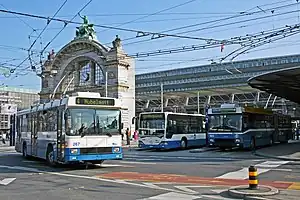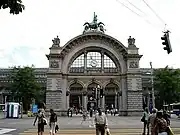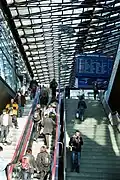Lucerne railway station
Lucerne railway station (German: Bahnhof Luzern) is a major hub of the rail network of Switzerland, in the city of Lucerne in the canton of Lucerne. It is a terminal station serving domestic and international traffic on several rail lines, and is situated in a city centre and waterfront location on the south side of Lake Lucerne.[6][1]
Luzern | |
|---|---|
 Bus station in front of the railway station | |
| General information | |
| Location | Lucerne Switzerland |
| Coordinates | 47°3′0.61″N 8°18′36.58″E |
| Elevation | 436 m (1,430 ft) |
| Owned by | Swiss Federal Railways |
| Line(s) | |
| Distance | [1] |
| Platforms | 7 island platforms |
| Tracks | 14 |
| Train operators | |
| Connections |
|
| Construction | |
| Architect |
|
| Other information | |
| IATA code | QLJ |
| Fare zone | 10 (Passepartout)[4] |
| History | |
| Opened | 1856 |
| Rebuilt |
|
| Key dates | |
| 5 February 1971 | A fire fully destroyed the building |
| Passengers | |
| 2018 | 97,900 per working day[5] |
| Services | |
| Location | |
History
The first station was opened on edge of Lake Lucerne in 1856 at the end of the Schweizerische Centralbahn main line from Olten and Basel where it connected with the French and German railways. The route of the railway—now the course of Pilatusstrasse (Pilatus Street)—was still undeveloped. The terminal station led directly to the pier for boat services on the lake and to the gates of the city of Lucerne. As a result, the area at the lake shore developed into an important railway junction. In the 19th century it rapidly developed into a hub with the introduction of steam navigation on the lake and the construction of several railway lines: the Gotthard railway, the line to Bern via Wolhusen, the line to Zug and Zürich and the metre-gauge Brünig railway. The first station was made of wood.
A new station was opened in 1896 with a large new building with a distinctive cupola. It was turned at almost 90° to the original station with its end to the north towards the bridge to central Lucerne, requiring a significantly changed approach line. The new approach had no level crossings of streets unlike the original route, but instead ran on embankments or in cuttings. The Brünig railway was also integrated into the new station. The tracks were electrified in 1922 along with the line from Olten. By 1910 the new station was nearing its capacity limits and an expansion plan was developed. However, the start of World War I prevented any work being carried out.
On the morning of 5 February 1971, fire broke out in the staff quarters of the station.[7] The fire was detected shortly after eight am, and at 8.18 the police was alarmed.[7] That day, the last train arrived 8.56am and the last departure of a train was 9 am.[7] The building burnt fiercely, and within an hour the cupola had collapsed, destroying the station frontage and concourse.[8] The service was restored with temporary buildings, allowing operations to be recommenced.[7] In 1980 a partnership of the Swiss Federal Railways, Swiss Post, the city and canton of Lucerne launched an architecture competition for a comprehensive redevelopment of the station. This also considered the future development of the rail approaches to Lucerne. However, a through station with a tunnel under Lake Lucerne was ruled out.
A new station was eventually built, and opened on 5 February 1991, exactly 20 years after its predecessor was destroyed.[7] The new station was planned by the architectural firm of Ammann and Baumann, and their then employee, Santiago Calatrava, designed the concourse of the new station. This is said to be the "heart of the new station, ... a multi-storey, generous sized public space that links the various functions of the city center with the railway". Its platforms are longer than those of the old station, and the underground shopping arcade is much larger.[8][9] In front of the new station, the arch of the old one with the sculpture Zeitgeist by Richard Kissling on top, is the be seen.[7]
In late 2012, a new tunnel route was opened on the Brünig line, between Kriens Mattenhof station and the approaches to Lucerne station. The tunnel replaces a less direct surface alignment, allowing the removal of several congested level crossings and the provision of double track, but terminal platforms used by Brünig line trains remain unchanged.[10][11]
.jpg.webp) An early photograph of the 1896 station
An early photograph of the 1896 station.jpg.webp) The same station in 1965, six years before it burnt down
The same station in 1965, six years before it burnt down The arc that now remains of the old station, with the sculpture Zeitgeist by Richard Kissling on top, with the new station frontage behind
The arc that now remains of the old station, with the sculpture Zeitgeist by Richard Kissling on top, with the new station frontage behind
Operation
The station is a terminal station serving domestic and international traffic on several rail lines. The lines from the east (Zürich–Lucerne and the Gotthard lines) pass to the north of Lucerne and then join the lines from the north (Olten–Lucerne line) and the west (Bern–Wolhusen–Lucerne line) and pass to the west of Lucerne before turning to approach the station from the south. The metre-gauge Brünig railway from the south and Interlaken also terminates at the station.[6][1] The station has seven island platforms with fourteen tracks, numbered 2–15.[12]
Bahnhofplatz occupies the area between the front of the station and the lakefront, and is heavily used by the local buses. The landing stages used by the passenger ships of the Schifffahrtsgesellschaft des Vierwaldstättersees (SGV) at Luzern Bahnhofquai occupy the lakeside of Bahnhofplatz, providing interchange between rail and water transport. The steamer operated section of the Gotthard Panorama Express departs from here on its voyage to Flüelen station at the other end of the lake, where passengers change into a panoramic train for the journey across the original line of the Gotthard railway to Bellinzona and Lugano.[6][13][14]
An underground shopping mall lies below both the concourse of the railway station and Bahnhofplatz.[6][13]
 The modern station frontage
The modern station frontage The interior of the train shed and platforms
The interior of the train shed and platforms Access to the underground level of the station
Access to the underground level of the station
Services
The following services stop at Lucerne:[15]
- EuroCity/InterCity: service every two hours between Basel SBB and Lugano; EuroCity continues from Lugano to Milano Porta Garibaldi.
- Voralpen Express: hourly service to St. Gallen.
- InterRegio:
- Luzern-Engelberg Express: hourly service to Engelberg.
- Luzern-Interlaken Express: hourly service to Interlaken Ost.
- half-hourly service to Zürich Hauptbahnhof, with every other train continuing to Konstanz.
- hourly service to Geneva Airport.
- one or two trains per hour to Basel SBB and one train every two hours to Locarno.
- RegioExpress/Lucerne S-Bahn S6: half-hourly service to Langnau, with every other train continuing from Langnau to Bern.
- RegioExpress: hourly service to Olten.
- Lucerne S-Bahn:
- S1: half-hourly service between Sursee and Baar.
- S3: hourly service to Brunnen.
- S4: half-hourly service to Stans, with every other train continuing to Wolfenschiessen.
- S41: weekday rush-hour service to Horw.
- S44: rush-hour service to Stans.
- S5: half-hourly service to Giswil.
- S55: rush-hour service to Sachseln.
- S6/S7: half-hourly service to Willisau; all S6 and some S7 trains continue to Langenthal.
- S9: half-hourly service to Lenzburg.
- S99: rush-hour service to Hochdorf.
Future proposals
In 2009, a study was initiated into the building of a new underground through station next to the current terminus, and after studying some 30 variants, the chosen variant was announced in July 2013. This involves the construction of a new 3.5-kilometre (2.2 mi) tunnel from Ebikon station, on the Zürich to Lucerne line, under the end of Lake Lucerne to an interim underground terminal station immediately to the east of the existing station. A second phase will add a second, 2-kilometre-long (1.2 mi), tunnel to join the standard gauge approach to the existing station at Heimbach, thus converting the underground station into a through station.[16]
If executed, this will significantly increase capacity on the Zürich to Lucerne line, by avoiding a single-track section of the existing line, and avoiding conflicts with the other standard gauge lines into the station. However, before the line can be built, the line must be funded. The first phase alone is estimated to cost CHF2.4 billion, and will be the subject of legislation and a national referendum, probably in 2014.[16]
References
- Eisenbahnatlas Schweiz. Cologne: Schweers + Wall. 2012. p. 22. ISBN 978-3-89494-130-7.
- "Liniennetz und Tarifzonen Agglomeration Luzern" (PDF) (in German). Tarifverbund Luzern/Obwalden/Nidwalden. 13 December 2020. p. 1. Retrieved 1 January 2021.
- "Sommer 22. 5. – 5. 9. 2021 (provisorisch)" (PDF). Lake Lucerne Navigation Company. 2021. Retrieved 6 May 2021.
- "Tarifzonen" (PDF). Tarifverbund Luzern/Obwalden/Nidwalden. 13 December 2020. Retrieved 1 January 2021.
- "Passagierfrequenz (2018)". Berne, Switzerland: SBB CFF FFS. 7 October 2019. Retrieved 6 November 2019 – via data.sbb.ch – SBB DATA PORTAL.
- map.geo.admin.ch (Map). Swiss Confederation. Retrieved 26 October 2013.
- Ribeli, Marc (5 February 2021). "Grossbrand im Bahnhof Luzern". Blog zur Schweizer Geschichte - Schweizerisches Nationalmuseum (in German). Retrieved 31 August 2022.
- "Lucerne pioneers the modern railway station". swissinfo.ch. Swiss Broadcasting Corporation. Retrieved 27 October 2013.
- Disch, Peter (1991). Architektur in der deutsche Schweiz 1980-1990. Ein Katalog und Architekturführer. Lugano: ADV-Verlag. p. 146. ISBN 88-7922-000-4.
- "Ausbau Zentralbahn" [Zentralbahn Expansion] (in German). Retrieved 15 January 2013.
- "Ausbau Zentralbahn - Ziele und Nutzen" [Zentralbahn Expansion - Objectives and Benefits] (in German). Retrieved 15 January 2013.
- "Stop: platform length (body)". data.sbb.ch. Retrieved 3 December 2022.
- "Luzern station plan" (PDF). Swiss Federal Railways. Retrieved 26 October 2013.
- "Timetable Gotthard Panorama Express". SBB. Archived from the original on 3 May 2022. Retrieved 3 May 2022.
- "Abfahrt: Bahnhof Luzern" (PDF). Swiss Federal Railways. 12 December 2021. Retrieved 2 October 2022.
- "New underground station for Luzern". Today's Railways Europe. Platform 5 Publishing Ltd. November 2013. p. 8.